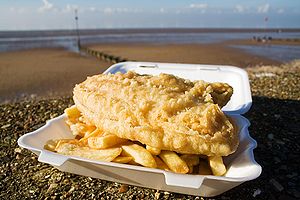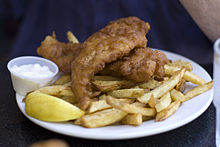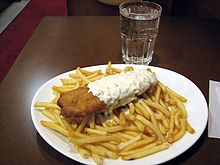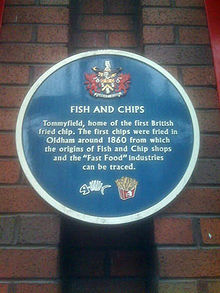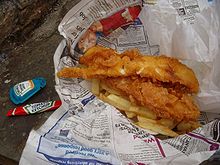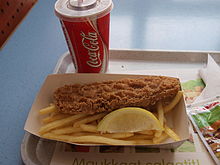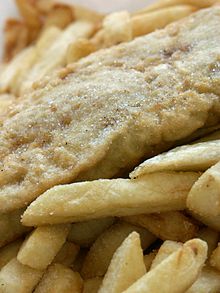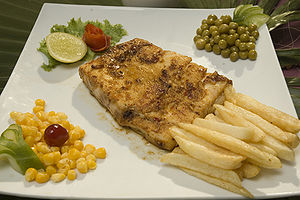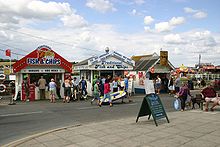- Fish and chips
-
Fish and chips (colloquially known as a fish supper in Scotland and Northern Ireland) is a popular take-away food in the United Kingdom, Australia, New Zealand and Canada. It typically consists of battered fish which is deep-fried and accompanied by chips.
The dish remains very popular in the UK and in areas colonised by British people in the mid 19th century.
Contents
History
Fish and chips became a stock meal among the working classes in Great Britain as a consequence of the rapid development of trawl fishing in the North Sea, and development of railways connecting ports to cities during the second half of the 19th century.[1] In 1860, the first fish and chip shop was opened in London by Jewish proprietor Joseph Malin.[2]
Deep-fried chips (slices or pieces of potato) as a dish may have first appeared in Britain in about the same period: the Oxford English Dictionary notes as its earliest usage of "chips" in this sense the mention in Dickens' A Tale of Two Cities (published in 1859): "Husky chips of potatoes, fried with some reluctant drops of oil". (Note that Belgian tradition, as recorded in a manuscript of 1781, dates the frying of potatoes carved into the shape of fish back at least as far as 1680.)[3]
The modern fish-and-chip shop ("chippy" or "chipper" in modern British slang[4][5]) originated in the United Kingdom, although outlets selling fried food occurred commonly throughout Europe. According to one story, fried-potato shops spreading south from Scotland merged with fried-fish shops spreading from southern England.[citation needed] Early fish-and-chip shops had only very basic facilities. Usually these consisted principally of a large cauldron of cooking-fat, heated by a coal fire. During World War II fish and chips remained one of the few foods in the United Kingdom not subject to rationing.[6]
In the United Kingdom and Ireland, the Fish Labelling Regulations 2003[7] enact directive 2065/2001/EC and generally means that "fish" must be sold with the particular species named; so "cod and chips", not "fish and chips". The Food Standards Agency guidance excludes caterers from this;[8] but several local Trading Standards authorities and others do say it cannot be sold merely as "fish and chips".[9][10][11]
England
The dish became popular in wider circles in London and South East England in the middle of the 19th century (Charles Dickens mentions a "fried fish warehouse" in Oliver Twist, first published in 1838), while in the north of England a trade in deep-fried chipped potatoes developed. The first chip shop stood on the present site of Oldham's Tommyfield Market.[12] It remains unclear exactly when and where these two trades combined to become the fish-and-chip shop industry we know today[update]. Joseph Malin opened the first recorded combined fish-and-chip shop in London in 1860 or in 1865, while a Mr Lees pioneered the concept in the North of England, in Mossley, in 1863.[13]
The concept of a fish restaurant was introduced by Samuel Isaacs (born 1856 in Whitechapel, London; died 1939 in Brighton, Sussex) who ran a thriving wholesale and retail fish business throughout London and the South of England in the latter part of the 19th century. Isaacs' first restaurant opened in London in 1896 serving fish and chips, bread and butter, and tea for nine pence,[14] and its popularity ensured a rapid expansion of the chain.
The restaurants were carpeted, had waited service, table cloths, flowers, china and cutlery, and made the trappings of upmarket dining affordable to the working classes for the first time. They were located in Tottenham Court Road, St Pancras, The Strand, Hoxton, Shoreditch, Brixton and other London districts, as well as Clacton, Brighton, Ramsgate, Margate and other seaside resorts in southern England. Menus were expanded in the early 20th century to include meat dishes and other variations as their popularity grew to a total of thirty restaurants. Sam Isaacs' trademark was the phrase "This is the Plaice" combined with a picture of the punned-upon fish in question. A glimpse of the old Brighton restaurant at No.1 Marine Parade can be seen in the background of Norman Wisdom's 1955 film One Good Turn just as Norman/Pitkin runs onto the seafront. Coincidentally, this is now the site of a Harry Ramsden's fish and chips restaurant. A blue plaque at Oldham's Tommyfield Market marks the first chips fried in Britain in 1860, and the origin of the fish and chip shop and fast food industries in Britain.[15]
Scotland
Dundee City Council claims that "...in the 1870s, that glory of British gastronomy - the chip - was first sold by Belgian immigrant Edward De Gernier in the city’s Greenmarket."[16]
In Edinburgh, a combination of Gold Star brown sauce and water or malt vinegar, known either simply as "sauce", or more specifically as "chippy sauce", has great popularity.[17]
Ireland
In Ireland, the first fish and chips were sold by an Italian immigrant, Giuseppe Cervi, who had stepped off an America-bound ship at Cobh and walked to Dublin. He started by selling fish and chips outside pubs from a handcart. He then found a permanent spot in Great Brunswick Street (now Pearse Street). His wife Palma would ask customers "Uno di questa, uno di quella?" This phrase (meaning "one of this, one of the other") entered the vernacular in Dublin as "one and one", which is still a way of referring to fish and chips in the city.[5]
Composition
Cooking
Traditional frying uses beef dripping or lard; however, vegetable oils, such as peanut oil (used due to its relatively high smoke point) now[update] predominate. A minority of vendors in the north of England and Scotland and the majority of vendors in Northern Ireland still use dripping or lard, as it imparts a different flavour to the dish, but it has the side effect of making the fried chips unsuitable for vegetarians and for adherents of certain faiths. Lard is used in some living industrial History museums, such as the Black Country Living Museum.
Thickness
British chips are usually significantly thicker than the American-style French fries sold by major multinational fast food chains, resulting in a lower fat content per portion. In their homes or in non-chain restaurants, people in or from the United States may eat a thick type of chip, more similar to the British variant, called "home fries" or "steak fries".[18][19]
Cooking fat penetrates a relatively shallow depth into the potato during cooking, thus the surface area reflects the fat content proportionally. Chips have a smaller surface area per unit weight than French fries and thus absorb less oil per weight of potato. Chips also require a somewhat longer cooking time than fries.
Batter
UK chippies traditionally use a simple water and flour batter, adding a little sodium bicarbonate (baking soda) and a little vinegar to create lightness, as they create bubbles in the batter. Other recipes may use beer or milk batter, where these liquids are often substitutes for water. The carbon dioxide in the beer lends a lighter texture to the batter. Beer also results in an orange-brown colour. A simple beer batter might consist of a 2:3 ratio of flour to beer by volume. The type of beer makes the batter taste different: some prefer lager[20][21] whereas others use stout or bitter. In all cases, the alcohol itself is cooked off, so little or none remains in the finished product.
Choice of fish
In Britain and Ireland, cod and haddock appear most commonly as the fish used for fish and chips,[22] but vendors also sell many other kinds of fish, especially other white fish, such as pollock or coley; plaice; skate and ray (particularly popular in Ireland); and huss or rock salmon (a term covering several species of dogfish and similar fish). In Northern Ireland, cod, plaice or whiting appear most commonly in 'fish suppers' - 'supper' being Northern Irish chip-shop slang for a food item accompanied by chips. Suppliers in Devon and Cornwall regularly offer pollock and coley as cheap alternatives to haddock due to their regular availability in a common catch. As a cheap, nutritious, savoury and common alternative to a whole piece of fish, fish-and-chips shops around the UK supply small battered rissoles of compressed cod roe.
Australians prefer reef-cod (a different variety from that used in the United Kingdom), barramundi or flake, a type of shark meat, in their fish and chips. In recent years, farmed basa imported from Vietnam has also become common in Australian fish and chip shops.
In New Zealand, at first, snapper was the preferred species for battered fillets in the North Island, but as catches for this fish declined, it was replaced by hoki, shark (marketed as lemon fish), and tarakihi. Gurnard and blue cod predominate in South Island fish and chips.
In the United States, the type of fish used depends on availability in a given region. Some common types are cod, halibut, flounder, tilapia or, in New England, Atlantic cod. Salmon is growing common on the West Coast, while freshwater catfish is most commonly used in the Southeast.
Accompaniments
In chip shops in the United Kingdom, salt and vinegar is traditionally sprinkled over fish and chips at the time it is served.[22] Suppliers may use malt vinegar, onion vinegar (used for pickling onions), or the much cheaper non-brewed condiment. A portion of mushy peas is a popular side dish.[23] In table-service restaurants and pubs, the dish is usually served with a slice of lemon and without any sauces or condiments, with salt, vinegar and sauces available at the customer's leisure.
In Ireland, Wales and Northern England, most takeaways serve warm portions of side-sauces such as curry sauce, sweet chilli sauce, or brown gravy. The sauces are usually poured over the chips. In some areas, this dish without fish is referred to as 'wet chips'. Other fried products include 'scraps', originally a by-product of fish frying. Still popular in Northern England, they were given as treats to the children of customers. Portions prepared and sold today consist of loose blobs of batter, deep fried to a crunchy golden crisp in the cooking-fat. The very popular potato scallop or potato cake consists of slices of potato dipped in fish batter and deep fried until golden brown. These are often accompanied for dipping by the warm sauces listed above.[24] Scraps are referred to as 'scrumps' around Bristol.
In Edinburgh and the Lothians salt and sauce (or saut an sauce) is the normal accompaniment traditionally sprinkled over fish and chips or almost anything else bought from the fish-and-chips shops. The watery "sauce" is a mixture of malt vinegar or non-brewed condiment and/or water and Rowat's or Gold Star brand brown sauce, and it is mixed and bottled—often in an old glass fizzy drink bottle with a hole pierced in the screw cap—by each fish-and-chip shop to their own secret recipe.
In Australia and New Zealand, seasoned salt or chicken salt is often sprinkled over fish and chips just before serving. Many customers now choose to salt food themselves, given current public health concerns about salt intake. Another popular condiment is tomato sauce. This is similar to ketchup, but sweeter and less astringent. Tartar sauce is also very popular for the fish. Both tomato and tartar sauce are usually sold in small plastic tubs on the shop counter. Complementary slices of lemon are generally served with the dish or takeout pack. In the best British and Irish tradition, malt vinegar is often the condiment of choice of many Australasian fish and chip lovers.
In Canada, fish and chips may be served with the traditional salt and vinegar, but a lemon wedge and tartar sauce is often the accompaniment found in table service restaurants. Coleslaw of both the vinegared or creamy variety is often interchangeably served as a side.
In the United States, most restaurants serve fish and chips with tartar sauce.
Vendors
In the United Kingdom, Australia, New Zealand and North America, fish and chips usually sell through independent restaurants and take-aways. Outlets range from small affairs to chain restaurants. Locally-owned seafood restaurants are also popular in many local markets. Mobile "chip vans" serve to cater for temporary occasions.[25] In the United Kingdom, punning names for the shops, such as "The Batter Plaice", "Assault and Battery", "The Codfather","The Frying Scotsman" and "The Fish Plaice" often occur. In countries such as New Zealand and Australia, fish-and-chip vendors are a popular business and source of income among the Asian community, particularly the Chinese migrants.[26]
Fish and chips is a common lunch meal eaten by families travelling to seaside resorts for day trips, who do not bring their own picnic meals.
Fish-and-chip outlets sell roughly 25% of all the white fish consumed in the United Kingdom, and 10% of all potatoes.
The existence of numerous competitions and awards for "best fish-and-chip shop"[27][28] testifies to the recognised status of this type of outlet in popular culture.[29]
Fish-and-chip shops traditionally wrapped their product in an inner layer of white paper (for hygiene) and an outer layer of newspaper or blank newsprint (for insulation and to absorb grease), though nowadays[update] the use of newspaper has largely ceased on grounds of hygiene, and establishments often use food-quality wrapping paper instead, which is occasionally printed on the outside to emulate newspaper. Fish and chip meals once came wrapped solely with a couple of layers of newspaper, but concerns over ink poisoning (especially relating to the use of lead type in newspaper production) meant the phasing out of this practice. Printing industry workers, however, state modern newspaper inks pose no such health risk.[30]
Fish-and-chip shops typically offer other hot fast food, which customers may eat in place of the traditional battered fish.
The British National Federation of Fish Friers was founded in 1913. It promotes fish and chips and offers training courses.
A previous world record for the "largest serving of fish and chips" held by an US restaurant was broken by Yorkshire pub Wensleydale Heifer in July 2011.[31]
Cultural impact
The long-standing Roman Catholic tradition of not eating meat on Fridays - especially during Lent - and of substituting fish for other types of meat on that day - continues to influence habits even in predominantly Protestant, semi-secular and secular societies. Friday night remains a traditional occasion for eating fish-and-chips; and many cafeterias and similar establishments, while varying their menus on other days of the week, habitually offer fish and chips every Friday.[32]
Environment
In the UK, waste fat from fish and chip shops has become a useful source of biodiesel.[33] German biodiesel company Petrotec have outlined plans to produce biodiesel in the UK, from waste fat from the British fish-and-chip industry.[34]
See also
Footnotes
- ^ "Fish and chips - A great British tradition". Archived from the original on 16 January 2008. http://web.archive.org/web/20080116221706/http://www.niagara.co.uk/fish_and_chips.htm. Retrieved 2009-06-22.
- ^ Rayner, Jay (2005-11-03). "Enduring Love". The Guardian (London). http://www.guardian.co.uk/lifeandstyle/2003/jan/19/foodanddrink.restaurants. Retrieved 2003-01-19.
- ^ "La Frite est-elle belge?". http://www.frites.be/v4/index.cfm?context=article&ContentID=354. Retrieved 2007-10-22. "According to Jo Gérard, our people already cooked chips prior to 1680. The historian offers as a proof a family manuscript dating from 1781 (Culinary curiosities in the Belgian Netherlands, signed by his great-great-uncle, Joseph Gérard)"
- ^ "Chippy smells of chips complaint". BBC News. 2006-11-07. http://news.bbc.co.uk/1/hi/england/west_yorkshire/6126476.stm. Retrieved 2009-06-22.
- ^ a b Hegarty, Shane (3 November 2009). "How fish and chips enriched a nation". The Irish Times (Dublin, Ireland): p. 17. http://www.irishtimes.com
- ^ "Resources for Learning, Scotland: Rationing". Rls.org.uk. 1998-01-05. http://www.rls.org.uk/database/record.php?usi=000-000-001-467-L. Retrieved 2009-06-22.
- ^ Fish Labelling Regulations (England) 2003, The Stationery Office, 2003, http://www.opsi.gov.uk/si/si2003/20030461.htm, retrieved 2009-04-04 (equivalent similary-named legislation applies in other countries of the UK and in Ireland)
- ^ Guidance Notes for England, Scotland, Wales and Northern Ireland, Office of Public Sector Information, 2003, http://www.food.gov.uk/multimedia/pdfs/fish_lab_reg2003gn.pdf, retrieved 2009-04-04 (Section A.2)
- ^ Food Labelling For Catering Establishments, Blackpool Council, http://www.blackpool.gov.uk/NR/rdonlyres/9DA031F1-E2EA-4198-8CC6-23644A89D6B1/0/FOODLABELLINGFORCATERINGESTABLISHMENTS.pdf, retrieved 2009-04-04
- ^ Business Advice Fact Sheet, Norfolk County Council, http://www.norfolk.gov.uk/consumption/groups/public/documents/general_resources/NCC048357.pdf, retrieved 2009-04-04
- ^ Labelling & Pricing, Nationwide Caterers Association, http://www.ncass.org.uk/default.aspx?id=1039, retrieved 2009-04-04
- ^ Chaloner, W. H.; Henderson, W. O. (1990). Industry and Innovation: Selected Essays. Taylor & Francis. ISBN 0714633356.
- ^ Historic uk - the heritage accommodation guide. "Tradition Historic UK, Fish and Chips". Historic-uk.com. http://www.historic-uk.com/CultureUK/FishandChips.htm. Retrieved 2009-06-22.
- ^ England Eats Out by John Burnett - Published by Pearson Education, 2004 ISBN 0-582-47266-0
- ^ The Portuguese gave us fried fish, the Belgians invented chips but 150 years ago an East End boy united them to create The World's Greatest Double Act Mail Online. Retrieved 21 September 2011
- ^ "Dundee Fact File". Dundee City Council. http://www.dundeecity.gov.uk/departments/fact.htm. Retrieved 20 March 2007.
- ^ SiteWise - Content Management System - www.pureenergymultimedia.com/sitewise/. "Did You Know?". Federation of Fish Friers. http://www.federationoffishfriers.co.uk/pages/81.htm. Retrieved 2009-06-22.
- ^ "Online recipes". Foodnetwork.com. http://www.foodnetwork.com/food/recipes/recipe/0,,FOOD_9936_31517,00.html. Retrieved 2009-06-22.
- ^ "More online recipes". Foodnetwork.com. http://www.foodnetwork.com/food/recipes/recipe/0,,FOOD_9936_36305,00.html. Retrieved 2009-06-22.
- ^ "Deep fried fish in beer". http://www.bbc.co.uk/food/recipes/database/deepfriedfishinbeerb_67776.shtml. Retrieved 2009-03-23.
- ^ Hix, Mark (2008-01-26). "Gurnard in beer batter". The Independent (London). http://www.independent.co.uk/life-style/food-and-drink/recipes/gurnard-in-beer-batter-772989.html. Retrieved 2009-03-23.
- ^ a b Alan Masterson, tictoc design. ""Seafish. On Plate. Fish & chips" (UK Sea Fish Industry Authority website)". Seafish.org. http://www.seafish.org/plate/fishandchips.asp. Retrieved 2009-06-22.
- ^ BBC. "Crispy fish & chips with mushy peas recipe - Recipes - BBC Good Food". http://www.bbcgoodfood.com/recipes/3411/crispy-fish-and-chips-with-mushy-peas. Retrieved 2010-03-07.
- ^ guardian.co.uk (2007-07-13). "Do you know what scraps are? And why they should be free". The Guardian (London). http://www.guardian.co.uk/lifeandstyle/wordofmouth/2007/jul/13/doyouknowwhatscrapsarean. Retrieved 2010-11-24.
- ^ http://www.mobilecateringuk.co.uk/how-to-start-up-mobile-catering-business.htm
- ^ Swillingham, Guy (2005). Shop Horror. London: Fourth Estate. ISBN 0-00-719813-2.
- ^ "The Fish & Chip Shop of the Year Competition". Seafish. http://www.seafish.org/plate/fishandchips.asp?p=gf182. Retrieved 2007-01-04.
- ^ "Frier's Quality Award". Seafish. http://www.seafish.org/plate/fishandchips.asp?p=gf502. Retrieved 2007-01-04.
- ^ "Couple scoop best chip shop award". BBC News. 2006-02-01. http://news.bbc.co.uk/1/hi/england/4670504.stm. Retrieved 2007-01-04.
- ^ Huber Group (September 2003). "Newspaper inks and the environment" (PDF). http://www.mhm.de/ti/ZD49102E.pdf. Retrieved 2007-10-27.
- ^ http://www.bbc.co.uk/news/uk-14003627 Giant fish and chip supper breaks world record
- ^ "Icons of England". Icons.org.uk. http://www.icons.org.uk/theicons/collection/fish-and-chips/features/meet-the-owners-the-golden-fish-bar. Retrieved 2009-06-22.
- ^ "German Biodiesel Firm To Use Chip Fat". Planetark.com. 2008-03-19. http://www.planetark.com/dailynewsstory.cfm/newsid/47581/story.htm. Retrieved 2009-06-22.
- ^ Michael Hogan (19 March 2008). "German Biodiesel Firm To Use Chip Fat In UK, US". planetark.com. http://www.planetark.com/dailynewsstory.cfm/newsid/47581/story.htm. Retrieved 1 October 2010.
External links
- "Top UK dish 'hooked French first'": BBC News: Fish and chips invented in France? Retrieved 2008-05-27
- "My plaice or yours?" - article from The Guardian detailing some chippy terminology. Retrieved 2008-05-27
- Far Flung Fish and Chips - historical article
- "Fish and chips": the (UK) Sea Fish Industry Authority's views. Retrieved 2008-05-27
- BBC TWO Ching He Huang-style fish and chips
- National Federation of Fish Friers, the UK industry body for fish and chip shops.
Categories:- English cuisine
- Australian cuisine
- New Zealand cuisine
- British cuisine
- Fast food
- Fish dishes
- Deep fried foods
Wikimedia Foundation. 2010.

